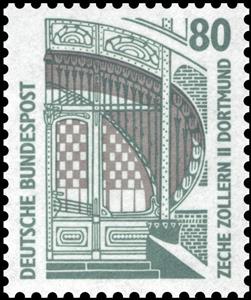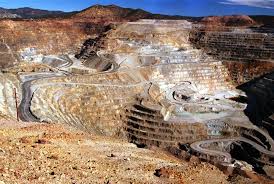Stamp: Zollern II Dortmund Mine Industrial Museum, Westphalia (Germany, Federal Republic 1992)
Zollern II Dortmund Mine Industrial Museum, Westphalia (Germany, Federal Republic 1992)
01 January (Germany, Federal Republic ) within release Sights goes into circulation Stamp Zollern II Dortmund Mine Industrial Museum, Westphalia face value 80 German pfennig
| Stamp Zollern II Dortmund Mine Industrial Museum, Westphalia in catalogues | |
|---|---|
| Michel: | Mi: DE 1342Av |
Stamp is square format.
Also in the issue Sights:
- Stamp - Tower of the Freiburg Minster face value 50;
- Stamp - Frankfurt Airport face value 10;
- Stamp - Main entrance of the mine Zollern II, Dortmund face value 80;
- Stamp - Nefertiti bust, Berlin face value 20;
- Stamp - Hambach castle face value 300;
- Stamp - Chile house, Hamburg face value 40;
- Stamp - Chile house, Hamburg face value 40;
- Stamp - Tower of the Freiburg Minster face value 50;
- Stamp - Frankfurt Airport face value 10;
- Stamp - Bronze pot, Reinheim face value 140;
- Stamp - Hambacher castle face value 300;
- Stamp - Main entrance of the mine Zollern II, Dortmund face value 80;
- Stamp - Nefertiti bust, Berlin face value 20;
- Stamp - St. Peter's Cathedral, Schleswig face value 33;
- Stamp - Bavaria, Munich face value 60;
- Stamp - Chile house, Hamburg face value 40;
- Stamp - Bavaria, Munich face value 60;
- Stamp - Frankfurt Airport face value 10;
- Stamp - Hambach Castle face value 300;
- Stamp - Tower of Freiburg Cathedral face value 50;
- Stamp - Zollern II Dortmund Mine Industrial Museum, Westphalia face value 80;
Stamp Zollern II Dortmund Mine Industrial Museum, Westphalia it reflects the thematic directions:
A building or edifice is a structure with a roof and walls standing more or less permanently in one place, such as a house or factory. Buildings come in a variety of sizes, shapes and functions, and have been adapted throughout history for a wide number of factors, from building materials available, to weather conditions, to land prices, ground conditions, specific uses and aesthetic reasons. Buildings serve several needs of society – primarily as shelter from weather, security, living space, privacy, to store belongings, and to comfortably live and work. A building as a shelter represents a physical division of the human habitat (a place of comfort and safety) and the outside (a place that at times may be harsh and harmful).
A miner is a person who extracts ore, coal, chalk, clay, or other minerals from the earth through mining. There are two senses in which the term is used. In its narrowest sense, a miner is someone who works at the rock face; cutting, blasting, or otherwise working and removing the rock. In a broader sense, a "miner" is anyone working within a mine, not just a worker at the rock face
A museum (/mjuːˈziːəm/ mew-ZEE-əm) is an institution dedicated to displaying and/or preserving culturally or scientifically significant objects. Many museums have exhibitions of these objects on public display, and some have private collections that are used by researchers and specialists. Compared to a library, a museum hosts a much wider range of objects and usually focus around a specific theme such as the arts, science, natural history, local history, and other topics. Public museums that host exhibitions and interactive demonstrations are often considered to be tourist attractions, and many museums attract large numbers of visitors from outside their host country, with the most visited museums in the world regularly attracting millions of visitors annually.
The United Nations Educational, Scientific and Cultural Organization (UNESCO; pronounced /juːˈnɛskoʊ/) is a specialized agency of the United Nations (UN) with the aim of promoting world peace and security through international cooperation in education, arts, sciences and culture. It has 194 member states and 12 associate members,as well as partners in the non-governmental, intergovernmental and private sector. Headquartered in Paris, France, UNESCO has 53 regional field offices and 199 national commissions




